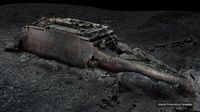A new documentary titled Titanic: The Digital Resurrection reveals groundbreaking insights into the RMS Titanic's tragic sinking, utilizing advanced 3D scanning technology to reconstruct the ship's final moments. The documentary, set to air on National Geographic on April 11, 2025, showcases a full-scale digital twin of the Titanic created by deep-sea mapping company Magellan, which took over 700,000 images of the wreck lying 3,800 meters beneath the Atlantic Ocean.
The Titanic, which sank during its maiden voyage on April 15, 1912, after striking an iceberg, has long been a subject of fascination and tragedy. More than 1,500 people lost their lives in the disaster, with only about 700 survivors. The new documentary allows filmmaker Anthony Geffen to challenge long-held assumptions and reveal new insights about the events of that fateful night.
According to Parks Stephenson, a Titanic analyst featured in the documentary, "Titanic is the last surviving eyewitness to the disaster, and she still has stories to tell." The digital model provides a comprehensive view of the wreck, akin to a crime scene, allowing experts to analyze the evidence within its context.
One of the significant findings from the scans is a visibly open steam valve in the ship's boiler room, suggesting that engineers worked tirelessly to keep the lights on until the very end. This corroborates accounts that a group of engineers remained at their posts for over two hours after the Titanic struck the iceberg, sacrificing their lives to maintain power and send distress signals.
"They kept the lights and electricity running until the end, to give the crew time to launch the lifeboats safely with some light instead of in absolute darkness," Stephenson explained. The team, led by chief engineer Joseph Bell, was instrumental in ensuring that the crew had a fighting chance to evacuate passengers.
Moreover, analysis of the wreckage shows that the Titanic did not break apart cleanly but was violently torn into two pieces as it sank. The scans reveal that the ship was subjected to a series of punctures along the hull, each about the size of an A4 sheet of paper, which led to catastrophic flooding. Simon Benson, an associate lecturer in naval architecture at the University of Newcastle, noted, "The difference between Titanic sinking and not sinking are down to the fine margins of holes about the size of a piece of paper." This finding challenges previous beliefs that a massive gash caused the sinking.
The documentary also highlights the personal belongings of passengers scattered across the seabed, providing a haunting reminder of the lives lost that night. The wreck is deteriorating rapidly, and experts warn that it could completely disappear within the next 40 years. However, the digital twin preserves the Titanic as it appeared in 2022, marking a significant advancement in underwater archaeology.
In addition to the engineers' heroic efforts, the documentary addresses the controversial legacy of First Officer William Murdoch, who has been scapegoated in various accounts, including the film Titanic by James Cameron. New evidence from the scans indicates that Murdoch did not abandon his post but was actively involved in launching lifeboats until the end. The position of a davit at his station supports testimony from surviving crew members that Murdoch was swept away while trying to save others.
"This davit is in the up position, meaning its crew is basically trying to get a lifeboat ready to be launched," Stephenson stated. This aligns with Second Officer Charles Lightoller's account, who saw Murdoch being washed away by a wave as he attempted to assist passengers.
As the Titanic's story continues to unfold through new technological advancements, the documentary Titanic: The Digital Resurrection promises to shed light on the complexities of the disaster and the human stories intertwined with it. With the digital scans providing an unprecedented glimpse into the wreck, researchers hope to preserve the Titanic's legacy and ensure that its lessons are not forgotten.
The scans and the insights they provide serve not only as a tribute to those who perished but also as a reminder of the importance of maritime safety regulations that have evolved since that tragic night. The Titanic was designed to be unsinkable, yet it suffered extensive damage that led to its demise, highlighting the need for continued vigilance in maritime safety.
As the documentary prepares to air, it invites viewers to reflect on the Titanic's enduring legacy and the stories of bravery, sacrifice, and tragedy that emerged from its sinking. With each revelation, the Titanic continues to teach us, ensuring that its history remains alive for future generations.





